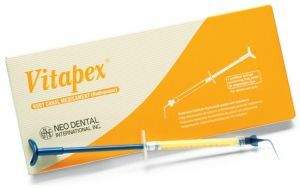 Vitapex( Vitapex) - a filling material based on calcium hydroxide and iodoform, is used in dentistry for use in endodontic procedures.
Vitapex( Vitapex) - a filling material based on calcium hydroxide and iodoform, is used in dentistry for use in endodontic procedures.
The material is used for root canal filling, for apexification and apexogenesis, for the formation of hard tooth tissues, as well as for the treatment of root resorption.
Contents
- Form and Composition
- Properties of
- Paste Application
- Instructions for use
- Dental pain and sensitivity
Form and Composition
The kit includes a two gram syringe with a paste and twenty disposable tips. The initial trial kit contains one 0.5-gram syringe and three disposable tips.
Full composition:
- 30.3% calcium hydroxide stimulates blast cells promoting apexogenesis, high pH neutralizes endotoxins produced by anaerobic bacteria;
- 40.4% iodoform improves radiopacity;
- 22.4% silicone oil provides a complete coating of the walls of the channel;
- 6.9% - other ingredients.
Solubilized calcium hydroxide remains active in the root canal.
Form release: 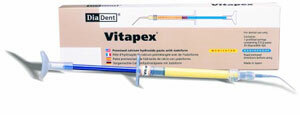
- 2 grams of paste in a syringe, 20 disposable tips;
- 2 grams of paste in a syringe;
- disposable tips Vitapex Cap VTN 40;
- Vitapex Intro Kit VNIN 0.5 g paste on syringe, 4 disposable tips;
- mini-syringe Vitapex VMS, 20 pieces in the kit.
Vitapex analogs available on the market:
- Iodine - 140-3000 rub;
- Kalasept - 400-500 rub;
- Metapex - 500-700 rub.
Properties of
paste The manufacturer reports that the resorption of Vitapex is approaching root resorption. The material is a soft, pre-mixed paste.
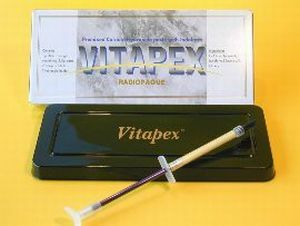 The paste is placed in the root and apical area with a plastic syringe and special tips. According to the manufacturer, the material is chemically and physically stable, has high radiopaque and excellent antibacterial and bacteriostatic properties.
The paste is placed in the root and apical area with a plastic syringe and special tips. According to the manufacturer, the material is chemically and physically stable, has high radiopaque and excellent antibacterial and bacteriostatic properties.
Twenty-six professionals rated Vitapex in 200 clinical situations. This material received a rating of 92%.
The paste can be used as a temporary or permanent material to fill the root canal after pulpectomy.
In addition, Vitapex:
- disinfects the channels;
- stimulates apexification;
- neutralizes endotoxins;
- stimulates the formation of hard tissues.
It is believed that calcium hydroxide has an antimicrobial effect and easily resolves if it is outside the apex of the tooth.
The antimicrobial action of calcium hydroxide is associated with its ionic dissociation into Ca2 + and OH- ions.
Scope of application
Indications:
- if necessary root canal filling - main application;
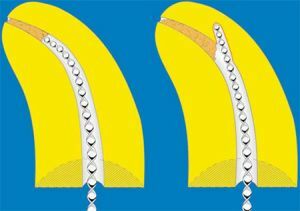
- exudation control - the paste prevents the leakage of blood and its constituents from the vessels into the tissues;
- material is used as a fixation for periapical disorders;
- root resorption;
- temporary root filling;
- in case of perforation of the tooth.
In addition, the material is indicated for use after pulpectomy in the treatment of the root canals of infant teeth.
Filling paste is also important in the restoration of cracked or broken teeth, as well as those that were erased in the process of improper functioning( bad habits, nail biting, etc.).
Instruction for use
First of all, the dentist removes the decomposed or destroyed part of the tooth, and then fills the resulting space with Vitapex paste.
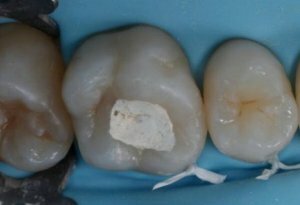 The patient is given a local anesthetic to numb the area around the tooth to be sealed.
The patient is given a local anesthetic to numb the area around the tooth to be sealed.
After which the removal of the affected area is performed, a special endodontic instrument or laser is used for this purpose. Then the area is cleaned and disinfected. If the lesion is close to the root, the dentist can first insert a special pad made of glass ionomer, composite resin or other similar material to protect the nerve.
After the performed procedures, Vitapex paste is applied directly from the syringe into the cavity treated with layers. Under the influence of light, the paste hardens. Cementing of the substrate and final polishing are carried out.
Dental pain and sensitivity
Excessive tooth sensitivity after filling with Vitapex is a fairly common problem. The tooth may be sensitive to pressure, air, sweet foods or temperature. Usually the sensitivity for several weeks is resolved by itself. During this time, everything that causes pain and discomfort should be avoided.
Contact your dentist if the pain persists for two to four days. The doctor can recommend a desensitizing toothpaste or apply a desensitizing agent.
